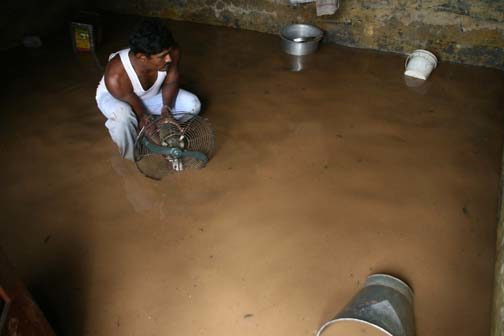Scores of people were feared dead and hundreds of people trapped in India’s Jammu and Kashmir state as incessant rain and windstorms triggered landslides and the worst floods in decades with several rivers in the Himalayan region flowing above the danger mark.
The floods have also caused major damage and killed scores of people in downstream Pakistan
The Jammu and Kashmir government sounded a red alert and confirmed the death of at least 10 people in the rains that lashed Jammu (in the plains) and mountainous Kashmir regions. However, media reports said the death toll was above 70 with 50 people being killed when their bus was washed away in flash floods in Jammu’s Rajouri district on Thursday.

Kashmir floods and the army
Officials were braced for the worst with the situation still unfolding and the weather office predicting more rain Saturday when the situation will likely worsen. It was the worst flood in Kashmir in decades, officials told reporters. An estimated 30 bridges were washed away and arterial roads cut off as the waters raged, causing massive destruction of property and crops like paddy and maize with the waters inundating fields.
The army was called in to help as was the National Disaster Response Force. Parts of the state’s summer capital Srinagar too were submerged and boats were being used to evacuate people. “The army has been asked to assist in the relief and rescue operations in submerged areas of south Kashmir and Srinagar city while six companies of the NDRF will be arriving…,” Kashmir Divisional Commissioner Rohit Kansal was quoted as saying.
What caused the Kashmir flood?
“Normally September is not a rainy season in Kashmir. But this year we have received massive rain because of the interaction between the western disturbances and monsoon currents and its effect is seen in all three regions of Kashmir,” Sonum Lotus, director of the meteorological department in Srinagar, told thethirdpole.net
Explaining further, he said Kashmir’s weather is mainly influenced by western disturbances originating from the Caspian Sea. Monsoon currents also leave their impact on Kashmir’s weather. “But this time around both have converged to pave way for heavy rains.”
South Kashmir has been particularly hit. The annual average rainfall for Kashmir is around 1,000 mm but some areas are expected to receive more than 350 mm rain in just four days from Tuesday to Saturday.
“Heavy rains cause the glaciers, which are quite prone to rapid-melting around this season, to melt faster if it rains incessantly in summer. This is what happened over the past two days as the rain and snow-melt have combined together to make the rivers to flow way above normal levels,” the official said.
The Jhelum river, Kashmir’s main river which originates in south Kashmir and snakes through major towns of the region including Srinagar, is flowing way above the danger mark with its water level recorded at 30 feet at some places.
“The level of water in river Jhelum at upstream Sangam in Anantnag district is well above the measurable mark of 34 feet… the measuring metre has disappeared, which has resulted in flooding of Anantnag and surrounding areas,” an official was quoted as saying.
“We have seen the level of Jhelum rise to 26 or 27 feet in the past but never beyond that,” he added.
Many other smaller rivers across the mountain-bound valley of Kashmir were also flowing above the danger mark, triggering panic in some areas. Many people left their homes for safer places after government authorities asked them to.
In Pulwama, for instance, reports said people of three dozen villages had fled their homes and taken refuge in safer areas.
Rescue operations were under way in the state with helicopters being pressed into service.
“We have also sent boats from Srinagar to south Kashmir for the rescue operations and our officers are ready to face any eventuality,” said state minister Nazir Gurezi, adding that the air force had also been requested to be on standby.
He said people had been given strict warnings to move from landslide prone areas and from areas near river banks to safer places. “We have also asked our officials to make staying arrangements for the people of the affected areas as we expect the situation to worsen,” the minister told thethirdpole.net.
In Jammu region, Rajouri and Poonch districts were the worst hit. Officials said more than 300 people were believed to be trapped and hundreds of homes had been swept away in places like Surankot and Reasi. In Reasi, five people, including three children, were killed when the strong winds and heavy rains triggered landslides and house collapses.
In a message to Jammu and Kashmir Governor N.N. Vohra, Indian President Pranab Mukherjee said: “I am deeply saddened to learn about the heavy rains leading to floods and landslides in certain areas of Jammu and Kashmir, which have caused loss of lives, injuries and damage to property. I understand rescue and relief operations are currently underway.”
Calling for all possible aid to those affected, he said, “Please convey my heartfelt condolences to the families of the deceased. I wish speedy recovery to the injured persons.”
![<p>An Indian Air Force helicopter evacuates victims of the 2014 floods in Jammu and Kashmir [Image by: Pacific Press Media Production Corp./Alamy]</p>](https://dialogue.earth/content/uploads/2014/09/Kashmir-floods-2014-scaled.jpg)
